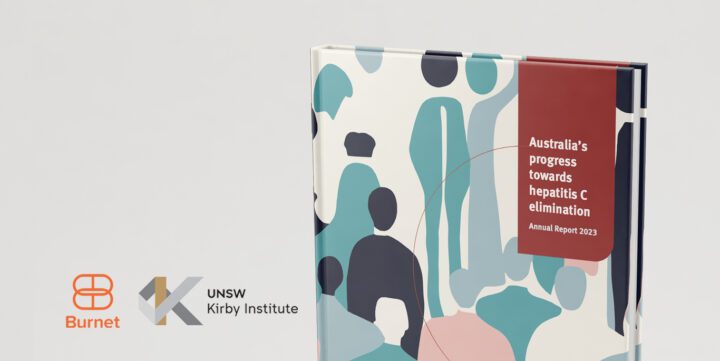Could Hepatitis C be eliminated by 2030?
December 14, 2023
Ambitious goals turn South in 2023
The Burnet Institute, in collaboration with Kirby Institute have unveiled a remarkable and inspiring goal: elimination of hepatitis C by 2030.
The eradication of hepatitis C as a public health concern by 2030 faces significant challenges, as evidenced by recent findings from a joint report by the Burnet Institute and the Kirby Institute. Despite the introduction of effective antiviral medications in 2016, which greatly enhanced treatment accessibility, there has been a concerning decline in both testing and treatment in recent years.
The report mentions that since March 2016, when these antiviral medications were included in the Pharmaceutical Benefits Scheme (PBS), allowing general practitioners to prescribe them directly, approximately 100,684 individuals living with hepatitis C have commenced treatment. This initial surge in treatment, however, has not been sustained. The year 2016 saw 33,202 people begin treatment, but by 2022, this number had dwindled to just 5,205—a stark decline that raises serious concerns about meeting the 2030 elimination target.
Gaps in treatment point to cultural barriers
Dr. Alisa Pedrana, public health expert at The Burnet Institute and editor of the report, highlights the initial success in treatment uptake due to the readiness of healthcare providers to diagnose and treat patients. However, the hoped-for stabilisation of treatment initiations around 10,000 per year has not materialised, indicating a significant gap in the current approach.
Dr. Pedrana points to insufficient testing as a major contributing factor to this decline. Even when diagnoses are made, transitioning patients to treatment remains a challenge. With only half of the diagnosed patients receiving treatment, it becomes clear that more than just diagnosis is required. The need for effective models that support treatment initiation is crucial, especially for those with complex needs, including comorbidities, homelessness, and histories of incarceration. The report also identifies stigma as a key barrier to progress. Stigmatisation of individuals at risk of or living with hepatitis C hinders their engagement with testing and treatment services, underscoring the need for interventions to combat this issue.
Professor Gregory Dore of the Kirby Institute emphasised the necessity of targeted strategies to build upon the early successes post-2016. He suggests that enhanced services, particularly in prisons and for marginalised populations, are vital for early detection and treatment.
Who is at risk?
Despite these challenges, experts like Dr. Pedrana and Professor Dore remain optimistic about achieving the 2030 elimination goal. However, this will require a concerted effort to design care models that effectively reduce barriers and reach those at highest risk. As the Department for Health and Aged Care reaffirms the 2030 target for hepatitis C elimination in its latest strategy, the importance of overcoming these hurdles becomes ever more pressing.
The Burnet Institute focuses on several key areas in its efforts to combat hepatitis C. They collaborate with virologists, immunologists, and mathematical modellers to deepen the understanding of hepatitis C, its transmission dynamics, and the management and care of those infected. Central to their approach is conducting innovative studies with key affected populations in Australia. These include people who inject drugs (PWID), who are at the highest risk of hepatitis C infection, men who have sex with men, the Aboriginal and Torres Strait Islander community, and prisoners. Additionally, the Institute is engaged in research aimed at understanding the mechanisms of hepatitis C virus entry and developing potential vaccine candidates. This is particularly significant given that, despite the existence of a cure effective in over 95% of cases, there is currently no effective vaccine for hepatitis C.
How will Hepatitis C be eliminated?
The Burnet Institute has set forth a series of comprehensive objectives aimed at achieving the elimination of hepatitis C in Australia by 2030, aligned with the World Health Organization’s (WHO) global viral hepatitis elimination strategy. Their approach is multifaceted, focusing on long-term solutions and building robust community foundations within Australian health systems. Here’s a breakdown of their goals:
- Collaboration with Key Partners: The Institute plans to work alongside crucial partners to support the achievement of the WHO’s hepatitis C elimination targets in Australia before 2030. This involves a collaborative effort with governmental and non-governmental organisations, healthcare providers, and community groups.
- Addressing Key Aspects of Hepatitis C Management: Their strategy includes addressing critical elements of hepatitis C management, such as diagnosis, delivery of direct-acting antivirals, prevention strategies, and the development of a hepatitis C vaccine. Each of these components plays a vital role in the overall strategy to eliminate the virus.
- Engagement with Affected Populations: Understanding hepatitis C transmission, risk, diagnosis, and care in key affected populations is a priority. This involves working directly with communities most impacted by hepatitis C, such as people who inject drugs (PWID), to improve health outcomes and reduce transmission.
- Establishing Surveillance Systems: To effectively combat hepatitis C, the Institute aims to establish surveillance systems to accurately measure its incidence and prevalence in Australia. This data is crucial for tracking progress and adjusting strategies as needed.
- Cohort Studies and Social Network Approaches: The Institute continues to follow cohorts of PWID, both those with and at risk of hepatitis C, using a social network approach. This helps in understanding the dynamics of the disease spread and the effectiveness of intervention strategies within these networks.
- International Research Collaboration: By working with key national and international researchers, the Institute aims to develop international cohorts of PWID with hepatitis C. This global perspective is essential for understanding the disease on a larger scale and developing strategies that can be applied universally.
- Research in Immunology and Virology: Collaborating with immunologists and virologists to understand the determinants of hepatitis C primary infection, reinfection, and naïve infection is another critical aspect of their work. This research is fundamental in developing effective treatments and preventive measures.
- Developing Models of Care: Working with health services, including major hospitals and community health services, the Institute aims to develop models of care to improve hepatitis C management, particularly in PWID. These models are crucial for ensuring that care is accessible, efficient, and effective.
- Guideline Development: In collaboration with national and international researchers and organisations, including the WHO, the Institute is involved in developing hepatitis C surveillance, testing, care, and treatment guidelines. These guidelines are essential for standardising and improving care across different settings.
Through these multifaceted approaches, the Burnet Institute aims not only to eliminate hepatitis C as a public health threat by 2030 but also to lay the groundwork for stronger, more resilient health communities in Australia, capable of addressing current and future health challenges. For those wanting to learn more about the global goals around hepatitis C elimination and the WHO’s support for this initiative, read more here: https://www.burnet.edu.au/knowledge-and-media/research-reports-plus-policy-briefs/australia-s-progress-towards-hepatitis-c-elimination-annual-report-2023/ and https://www.globalhep.org/
Burnet Institute and Kirby Institute. Australia’s progress towards hepatitis C elimination: annual report 2023. Melbourne: Burnet Institute; 2023. https://www.burnet.edu.au/knowledge-and-media/research-reports-plus-policy-briefs/australia-s-progress-towards-hepatitis-c-elimination-annual-report-2023/












